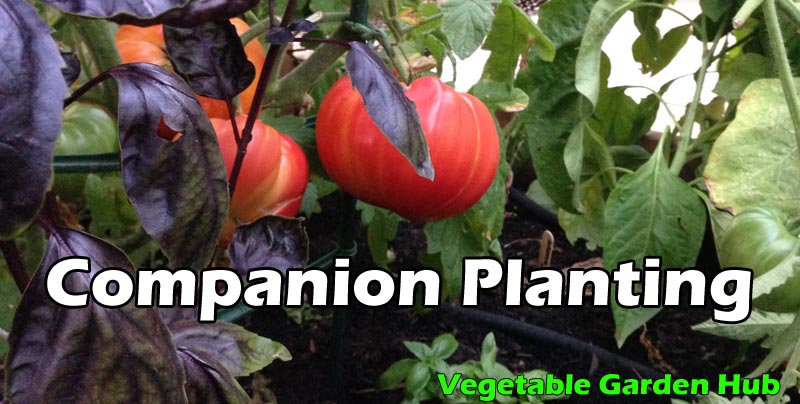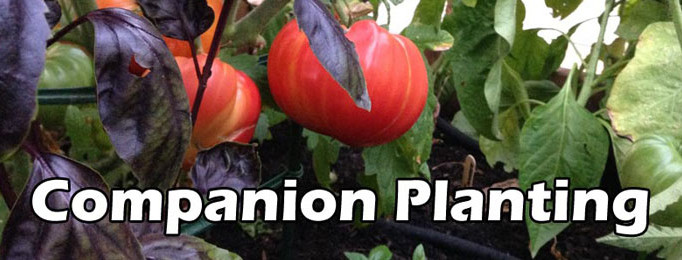 Whether it’s simple companion planting or permaculture guilds, recognizing who gets along (and who doesn’t!) and planting accordingly is the first step in understanding plant relationships in the garden. Learning the various roles and functions of differing plant types and using these relationships to enhance the health and vigor of your entire garden, can drastically improve your success as a gardener.
Whether it’s simple companion planting or permaculture guilds, recognizing who gets along (and who doesn’t!) and planting accordingly is the first step in understanding plant relationships in the garden. Learning the various roles and functions of differing plant types and using these relationships to enhance the health and vigor of your entire garden, can drastically improve your success as a gardener.
Getting Started with Companion Planting in the Garden
Companion planting can start as easily as grouping together peppers, eggplants and tomatoes in a single garden bed, and adding a planting of carrots around the base of the tomato and pepper plants. The carrots will give increased yield and flavor to the tomatoes, and improved health and yield to the peppers. The carrots will also have improved flavor.
Adding a selection of herbs will improve insect pest control and the attraction of pollinators. Basil and parsley are both excellent choices for this summer loving nightshade bed. Basil will flourish in the cool understory of the towering tomatoes, and parsley will find support from the tomato stems and protection from too much sun.
Add flowers and fragrant plants to increase diversity to confuse garden pests and support all aspects of the garden health, so long as an understanding of companion relationships is used as a guide.
Plant nasturtium around borders of tomato beds to improve their flavor. Other great companions for the tomato, pepper and eggplant bed are geranium, calendula, borage, oregano, chives, and onions. You don’t need to include all the companions, but diversity will distract pests and provide value to the plants from their companions.
Marigolds and yarrow, can be planted throughout the garden and both repel soil nematodes, aphids, bean beetles and many other pests.
If you love your cabbages, broccoli and kales, you’ll want to plant a lot of dill and other aromatic herbs such as rosemary, sage, geranium, garlic and onion in their beds to help deter cabbage moth worms and other brassica loving pests.
Nasturtium can be used in brassica beds to create ‘pest traps’ for slugs and aphids, both of which are attracted to the succulent brassicas. Plant nasturtium along the borders and edges of brassicas and remove infested leaves and flowers to the chicken pen or hot compost pile.
The Three Sisters
Most gardeners know the ‘three sisters’ of corn, beans and squash, which create a nice companion grouping which demonstrates the expanded plant roles and support systems found in permaculture plant guilds.
The corn supports the bean vines and the squash provides a protective shade and thorny leaf covering over the ground keeping both the beans and corn roots moist. Corn is a heavy nitrogen feeder and beans are nitrogen fixers, which take up nitrogen out of the air and deposit it along their root nodes where the corn plants can use it.
The Permaculture Guilds
Permaculture Guilds are groups of companions, or plant communities which work well together, from understories to canopies. Trees, climbing vines, high and low bushes and shrubs, smaller ground huggers and sub-soil bulbs and root crops can all have specific cross-beneficial relationships in the garden.
Guilds are generally centered around different types of trees, which serve as the central planting and focus of the guild. Some guilds are more diverse than others, and guilds are, like everything in permaculture, adaptable by those who observe and experiment with what they see in nature.
Fruit Tree Guild
These guilds have a central fruit tree and groups of different types of plants which will perform certain functions in the community. Different fruit trees will have different specific plants in these plant groups, which will work well together and with the main tree of the guild.
There are four main areas of relationship and interaction within the supporting members of a guild. These are accumulators, suppressors, attractors and repellers:
- Accumulators provide the accumulation of minerals and nutrients important to all members of the guild.
- Suppressors will inhibit the growth of unwanted plants which might rob nutrients from guild members.
- Attractors and Repellers will attract or repel certain insects, animals and/or other non-plant helpers and pests.
One of the primary roles of accumulators is to fix nitrogen in the soil. Leguminous groundcover plants such as clover and vetch are often planted as cover crops between planting cycles, while shrubs and trees can be interplanted and cut back or trimmed at various times during the season to control their growth and add additional matter to the soil. Autumn Olive, Silverberry, any of the many varieties of Pea Shrub, Goumi, Bea Buckthorne and many others can fulfill this role in the permaculture guild.
Suppressors act in a very different way, and can be used to suppress weeds, and even repel animals. Bulbs are often used as suppressors as they crowd out grasses, add nutrients to the soil when their thick fleshy leaves break down in summer, do not compete for water during the summer when they are dormant, and can even be poisonous to foragers like deer, or ground squirrels. Daffodils, garlic, onion, and a wide variety of lilies can be very effective suppressors in a permaculture guild.
The next two groups of plants in the guild are the attractors and the repellers. Attractors encourage insects who will pollinate the fruit trees, for example, and repellers are plants which will repel pest insects. In an apple guild, some excellent attractors are fennel, coriander and dill, which not only attract pollinators but also attract predatory wasps who will lay their eggs in the larvae of pests like the brown apple moth. Another repeller for apples is nasturtium which helps repel apple tree pests, and can be planted to form large blooming swaths at the base of the apple tree.
Finally, the last group of plants to aid the apple and provide support to the guild are the suppressors. These are the plants which help to keep down the overgrowth of unwanted plants in the community.
The Apple Guild
The apple guild has specific members with an affinity to apples that may not be shared by other fruit trees. The most noticable of these is fennel, a plant which is well known for not getting along with much of anyone in the garden, but which offers benefit when planted with apples and which thrives in the partial shade of a mature apple tree.
As in all areas of permaculture, the longer a gardener works with specific plants in particular environments, the more detailed information he or she will gather to aid in the creation of new and different types of guilds.
Learn the science behind companion planting in your organic garden.
Leverage the effects of various plants on their environment to your advantage.
Recommended Websites
Golden Harvest Organics
Midwest Permaculture – Plant Guilds – Free eBook
Recommended Books


